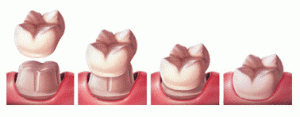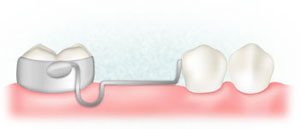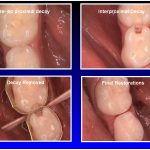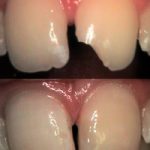Sealants
Dental sealants are a thin plastic coating painted on the chewing surface of the teeth to prevent tooth decay. Sealants bond into the grooves of the teeth, forming a protective shield over the enamel of the tooth. Sealants make the tooth a smoother surface to help prevent food from getting trapped inside the tooth, which ultimately helps prevent cavities from developing. They are typically white or clear in color.
Fillings
A white filling, also known as Composite or Resin fillings, are used to restore teeth that have cavities. They are made up of plastic, glass and ceramic compound and are similar to the appearance of natural teeth. When a patient has a small to medium size cavity, a white filling is recommended to restore the tooth structure. Unlike silver, amalgam fillings, less tooth structure is removed, and white fillings harden in seconds rather than needing a few days to harden and set.
Crowns
Silver crowns, made up of stainless steel metal, are sometimes needed to restore a tooth that has a very large cavity. Once the decay is removed and there isn’t much tooth structure left to support a white filling, a crown is recommended. When placing a crown on a baby tooth, the tooth is reduced and a prefab ricated crown is fitted onto your child’s tooth. After the correct size is selected and your child’s bite is adjusted, the crown is cemented on the tooth using a special dental cement. A silver crown will ensure that the tooth has less chance of fracturing or breaking, which will reduce the risk of a new cavity or infection developing. To help increase the longevity of stainless steel crowns, it is encouraged that patients clean along the gum line of the crowned tooth and avoid eating hard, sticky foods, such as chewing gum, caramels, and gummy snacks. Our office also offers the following:
ricated crown is fitted onto your child’s tooth. After the correct size is selected and your child’s bite is adjusted, the crown is cemented on the tooth using a special dental cement. A silver crown will ensure that the tooth has less chance of fracturing or breaking, which will reduce the risk of a new cavity or infection developing. To help increase the longevity of stainless steel crowns, it is encouraged that patients clean along the gum line of the crowned tooth and avoid eating hard, sticky foods, such as chewing gum, caramels, and gummy snacks. Our office also offers the following:
- Strip Crowns (White Composite Crown)
- Cheng Crowns (Silver back/white front)
- Zirconia Crowns (Ceramic)
Space Maintainers
Sometimes a primary, “baby” molar tooth may fall out prematurely due to trauma, an infection or insufficient space in the mou th. If the permanent tooth underneath the baby tooth is not close to erupting, a space maintainer is needed. A space maintainer is a small appliance used to hold the empty space for the permanent teeth until it is ready to erupt. If a space maintainer is not placed after early removal of a baby tooth, the teeth could drift into the empty space, creating crowding and blocking the eruption of a permanent tooth. These appliances require us to see your child for two separate appointments: impressions (mold) of their teeth, and another appointment to cement the appliance. Most children adjust to these appliances after a couple days and special oral hygiene and diet instructions will be given to help care for your child’s teeth and the space maintainer.
th. If the permanent tooth underneath the baby tooth is not close to erupting, a space maintainer is needed. A space maintainer is a small appliance used to hold the empty space for the permanent teeth until it is ready to erupt. If a space maintainer is not placed after early removal of a baby tooth, the teeth could drift into the empty space, creating crowding and blocking the eruption of a permanent tooth. These appliances require us to see your child for two separate appointments: impressions (mold) of their teeth, and another appointment to cement the appliance. Most children adjust to these appliances after a couple days and special oral hygiene and diet instructions will be given to help care for your child’s teeth and the space maintainer.
- Dr. Ruby speaking with his patient during an exam
- Dr. Ruby giving his recommendations for treatment
- Dr. Ruby performing a routine 6 month check up
- Dr. Ruby during treatment
- Dr. Rochon during treatment
- The process of decay and how it is restored
- The process of decay and how it is restored
- Before & After Chairside Veneer
- Before & After Crown Placement









